In an era where environmental consciousness is at the forefront of industrial processes, choosing the right filtration technology is critical. The decision extends beyond achieving regulatory compliance; it has a profound impact on the environment. This blog delves into the pivotal subject of evaluating the environmental footprint of different filtration technologies, shedding light on the aspects to consider when making informed choices.
Filtration Technologies: A Crucial Environmental Factor

Industrial facilities across various sectors rely on filtration systems to manage air quality, control emissions, and safeguard both public and environmental health. These systems act as environmental gatekeepers, preventing pollutants and particulate matter from being released into the atmosphere. From baghouses to electrostatic precipitators (ESPs), and more recently, innovative hybrid approaches, these systems are central to reducing the release of pollutants into the environment.
Efficiency vs. Environmental Impact: A Delicate Balance
One of the primary factors to assess when choosing a filtration technology is its efficiency in capturing pollutants. Higher efficiency typically equates to better environmental protection, but it’s not the whole story. To understand the complete picture, one must also consider the energy required for filtration and its associated carbon footprint. It’s essential to strike a balance between efficiency and energy consumption to optimize the environmental impact. For instance, an ultra-efficient system may consume an excessive amount of energy, making it less environmentally friendly than a more balanced solution.
Lifecycle Analysis: Beyond Operation
Performing a lifecycle analysis is an integral part of assessing a filtration technology’s environmental effect. This analysis considers not only the operational phase but also the manufacturing, installation, and maintenance phases. When evaluating different filtration technologies, it’s crucial to understand the environmental implications throughout their entire lifecycle. This perspective includes aspects such as raw material extraction, transportation, and disposal at the end of life. An effective filtration technology should demonstrate an environmentally conscious approach in every phase of its existence.
Material Selection and Resource Usage: The Environmental Ingredients
The choice of materials in filtration systems can significantly impact their environmental footprint. Sustainable materials, lower energy usage during manufacturing, and ease of recycling or disposal should be the focus. Modern filtration technologies often prioritize using materials with minimal environmental impact. They also consider the potential for reusing materials or recovering them for subsequent use. By minimizing waste and optimizing material selection, these technologies reduce their environmental footprint.
Carbon and Energy Footprint: Measuring Efficiency
The energy required to operate a filtration system directly contributes to its environmental impact. Understanding the source of the energy used and the potential for alternative energy sources is vital. Filtration technologies should aim to minimize their carbon and energy footprint during operation. Additionally, they should explore opportunities for energy recovery or optimization. By reducing energy consumption and embracing cleaner energy sources, these technologies can enhance their environmental credentials.

Tailoring Filtration Solutions: A Bespoke Approach
The environmental impact of filtration systems is not a one-size-fits-all concept. It varies across industries and even within different applications. Understanding this, filtration technologies should be tailored to specific requirements. What works for one industry may not be the best fit for another. Hence, it’s essential to conduct a thorough analysis of the specific environmental challenges and goals. By aligning filtration technologies with both regulatory requirements and industry-specific environmental aspirations, industries can enhance their environmental performance.
Conclusion: Pioneering Environmental Responsibility
As industries worldwide embrace greater environmental responsibility, the role of filtration technologies takes center stage. Selecting the right technology involves a comprehensive evaluation that considers efficiency, materials, energy consumption, and the complete lifecycle. It is through such meticulous assessments that we can truly evaluate and reduce the environmental impact of different filtration technologies. By doing so, we pave the way for cleaner air, a healthier planet, and a sustainable future. This journey is not just about compliance; it’s about creating a positive impact and leaving a legacy of environmental stewardship for future generations.